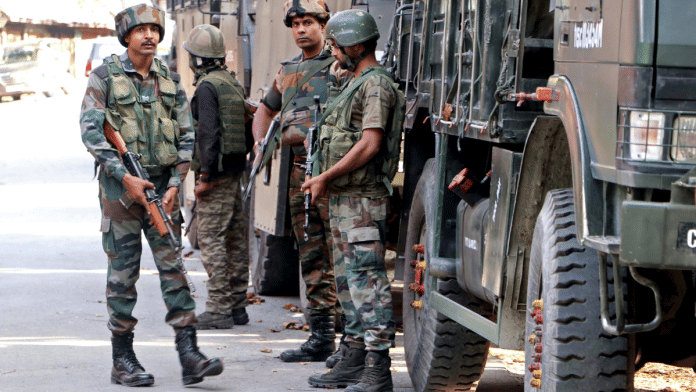New Delhi: Last week’s operation in the jungles of Chatroo in Jammu region’s Kishtwar district—which led to the death of two soldiers, including a Junior Commissioned Officer (JCO), and injuries to two others—followed a troubling pattern seen in some of the previous encounters, too, ThePrint has learnt.
The encounter had taken place on 13 September and the 16 Corps had posted on X that a firefight was established and the “scout leading the patrol exchanged heavy volume of fire with the terrorists at 1530 hrs”.
Sources in the defence and security establishment said that while a group of security personnel belonging to the 11th Rashtriya Rifles (11RR) and local police did enter in the jungles on an operation, the firing was not initiated by them.
It is learnt that a group of terrorists, who the security personnel were after, had managed to set up an ambush in which one of the two teams that had gone out were caught while returning.
Sources said an intelligence report was received about a group of terrorists trying to cross over from Jammu region’s Kishtwar to South Kashmir’s Anantnag district.
The intelligence was regarding the group of terrorists belonging to Pakistan-based terror group Jaish-e-Mohammad (JeM). According to media reports from Jammu that day, this was the same group responsible for the July attack on an Army patrol in Doda’s Desa area, which had killed four soldiers, including Captain Brijesh Thapa.
Sources said based on the intelligence, two teams of scouts of about 12 soldiers were formed and sent out. The plan was to converge on the suspected area from two sides while the rest of the soldiers followed.
In any operation, a scout team is ahead of the main party and their job is to observe what is in the front and inform the main team coming up behind.
However, one of the two parties came under guided controlled fire in which the terrorists hit the JCO who was leading the team and managed to injure three others.
It is learnt that there was an attempt to mutilate at least one of the two killed soldiers.
However, as other soldiers opened fire after regrouping themselves following the initial shock, the terrorists pulled away as usual.
Defence sources told ThePrint that this was indeed an intelligence-based operation and intelligence is the bedrock of any counter terrorism or counter insurgency operation.
They said that, at times, the delivery of exact intelligence gets delayed, or one may not reach a location at the right time because of the terrain and logistics involved.
The sources added that the intelligence was solid but the forces took time to reach the location because of the terrain.
Asked about the attempted beheading of the soldier which resulted in mutilation of the body, the sources said that they had no such inputs.
Also read: Security beefed up in Jammu region ahead of polls but attacks since 2021 point to pattern
What the trends show
ThePrint had, in November last year, flagged the troubling trend of killings in the Jammu division, which had been peaceful for nearly 15 years.
The pattern shows that in several encounters in the Jammu region, the security forces receive a tip-off that a certain number of terrorists are hiding in the thick jungles. As the forces make their way to the probable site, they are ambushed by the hiding terrorists. More teams that come in to evacuate the injured are also ambushed.
An analysis of all deaths and encounters in the Jammu region since 2021 shows that the terrorists have had the upper hand in choosing the place and time of attacks.
The main reasons of this surge of terror, as ThePrint reported, was complacency on behalf of security forces because of years of peace, lack of ground intelligence, infiltration of nearly 40-50 well-trained Pakistani terrorists with sophisticated weapons and thinning down of deployment over the years and more especially since the stand-off with China in Ladakh which began in 2020.
(Edited by Zinnia Ray Chaudhuri)
Also read: India’s quest for small arms continues, with some twists and turns and heartburn along the way






